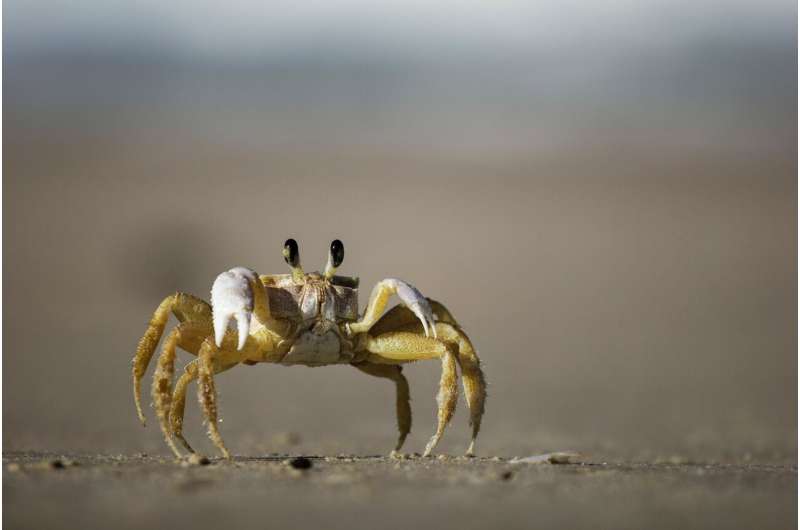In animal battles, cheaters can win

Two knights stand face to face. One has a plain average-sized sword. The other has a massive fear-inducing sword stained with blood. After one quick look at it, the first knight quickly puts his average sword away, backs off to a safe distance, and runs for his life.
He'll never know that the massive fear-inducing sword was actually a plastic toy.
In a new study appearing Feb. 9 in the journal Biology Letters, Jason Dinh, Ph.D. candidate in Biology at Duke University, shows that animal weapons can be a lot like plastic swords: impressive, but ultimately cheap.
From deer antlers to lobster claws, many animals have weapons. These are often large, clunky and heavy appendages that are metabolically costly for the animal to maintain. In clawed crustaceans, such as shrimps, lobsters, and crabs, their weapons can weigh more than a third of the animal's body mass. That's a lot of extra tissue to feed and maintain, even when the animal is perfectly still.
"Some animals can spend 40% of their energy budget for the day just maintaining themselves sitting there doing nothing," Dinh said. "It's a very slow and steady cost that's happening throughout the animal's adult life."
In many of these species, larger individuals have disproportionally larger weapons. For example, if a small animal's weapon weighs 2 grams, the weapon of an animal twice as big may weigh 5 grams, more than double the small animals' weapon size. This means that larger animals also have a disproportionately larger energy cost of maintaining that weapon.
Unless… they cheat.
Muscles require lots of energy to remain viable, but chitin, the main component of a crab's shell, is mostly inert. Once produced, it costs virtually nothing to maintain. The same goes for keratin, which comprises rhino horns, bird feathers, and your fingernails.
Using two species of snapping shrimps and one species of fiddler crab, Dinh set out to test if animals could be minimizing the maintenance cost of their weapons by building them out of cheap tissues, such as chitin.
For each species, he looked at the relationship between weapon size and the ratio of soft, expensive tissue to hard, cheap exoskeleton. He found that the larger the weapon, the higher the proportion of exoskeleton it contained. That is, the muscle doesn't grow proportionally, leaving larger weapons with more cheap crunch, but less expensive muscle.
Even within a similar body-size range of a species, some individuals can have markedly exaggerated weapons. Dinh looked at the relationship between exaggeration and the ratio of soft tissue to exoskeleton and found that, regardless of body size, exaggerated weapons also had disproportionately more exoskeleton. Once again: More crunch, less muscle.
"These individuals with exaggerated claws are pretty good at deceiving their opponents," said Dinh. "Their opponents have trouble assessing whether they're bigger, stronger, or simply have an exaggerated claw."
That's not to say that an exaggerated claw is just a prop weapon. Dinh says that among fiddler crabs who pinch and push each other, a bigger claw may have advantages in direct combat. In snapping shrimps, that fight by throwing extremely high-pressure bubbles at each other, larger claws may also present an advantage.
"It's a way animals can deceive, but they can also improve their performance during these fights, and apparently they can do it in a really cheap way," he said.
A knight with a plastic sword would sooner or later be found out, but heavily armed animals may be able to get away with it. Many crustacean battles are won by intimidation, and even when they do escalate to full-blown violence, they are rarely lethal. And, unlike human knights, if a claw gets ruined in combat, they can amputate it and grow a new one.
Dinh draws parallels between crustaceans and much bigger animals, such as chameleons, deer and elephants whose weapons are made mostly of inert materials.
"We think of these weapons and ornaments as honest indicators of how good of a fighter an individual is, but animals seem to be able to play these nice physiological tricks to really cheaply deceive or exaggerate how strong they are during these fights, said Dinh, "and it's primarily by using cheap tissues instead of muscles."
More information: Large and exaggerated sexually selected weapons comprise high proportions of metabolically inexpensive exoskeleton, Biology Letters (2022). DOI: 10.1098/rsbl.2021.0550. royalsocietypublishing.org/doi … .1098/rsbl.2021.0550
Journal information: Biology Letters
Provided by Duke University

















